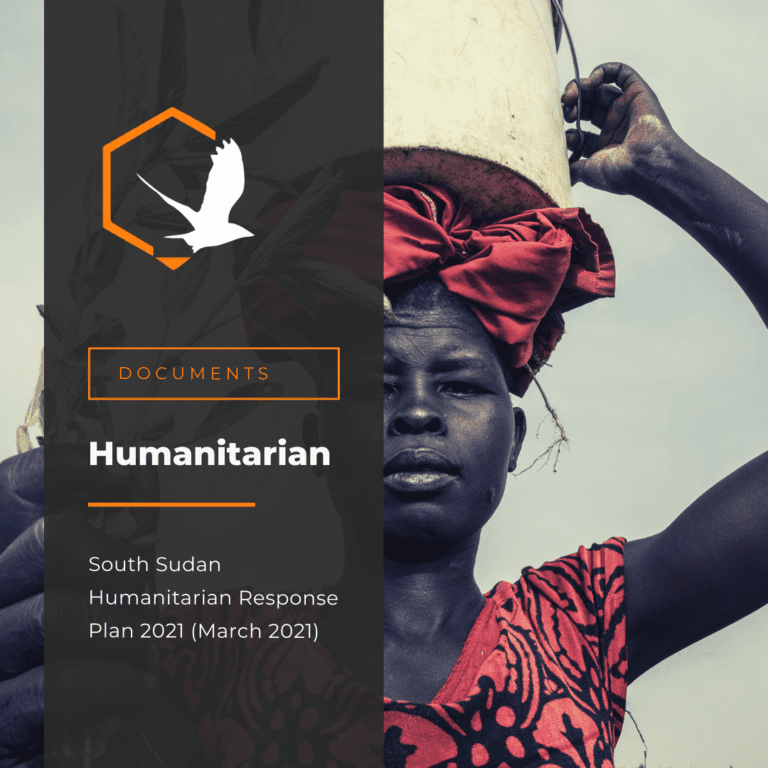Response Plan Overview
- PEOPLE IN NEED 8.3M
- PEOPLE TARGETED 6.6M
- REQUIREMENTS (US$) $1.68B
- OPERATIONAL PARTNERS 195
The 2021 South Sudan Humanitarian Needs Overview (HNO) identified 8.3 million people, including refugees, in need of humanitarian assistance across the country. This is an 800,000-person increase in absolute numbers from the 7.5 million people in need in 2020.
Informed by a rigorous inter-sectoral prioritization process, the 2021 Humanitarian Response Plan (HRP) will target 6.6 million people1 across all 78 counties, including one county – Pibor – classified in the HNO as in catastrophic need, another 72 counties where the humanitarian needs are extreme, and five counties with severe humanitarian needs.
The humanitarian operation will be guided by three overarching strategic objectives listed above. The Centrality of Protection will be at the core of the humanitarian response, including the prevention of and response to gender-based violence (GBV). In support of the humanitarian-development nexus approach, the humanitarian community will be working closely with durable solutions, development and peacebuilding actors to address the drivers of humanitarian needs and adopt conflict-sensitive approaches.
Immediate response priorities include sustaining the ongoing, multisector response scale-up in the six most food insecure areas and preparing for the 2021 rainy season, which is forecasted to lead once again to major floods.
A robust response monitoring framework will provide the Humanitarian Country Team (HCT) with evidence to ensure a timely, efficient, and fit-for-purpose response to the humanitarian needs. The set-up of humanitarian hubs in key locations across the country in 2021 aims to expand humanitarian access for improved response.
Humanitarian partners need US$1.68 billion to implement a highly focused and prioritized response plan in 2021.
Crisis Context and Impact
The humanitarian situation in South Sudan remains dire.
More than two-thirds of the South Sudanese population and some 300,000 refugees and asylum seekers in South Sudan are in need of some form of humanitarian assistance and protection in 2021, as the country continues to experience the cumulative effects of years of conflict, a surge in sub-national violence, unprecedented flooding and hyperinflation, further compounded by the COVID-19 pandemic. The lack of durable peace and limited investment in basic services impedes many people’s ability to move towards sustainable development.
South Sudan remains one of the most severe protection crises in the world with high levels of GBV and reports of significant gross human rights violations across the country. Some 1.6 million people remain internally displaced, including 125,000 people who are sheltering in two remaining Protection of Civilians (PoC) sites. Another 2.2 million South Sudanese refugees have fled to neighboring countries and, despite some modest improvements in the political and security situation, do not yet consider it safe to return home in large numbers.
The country is now facing its highest levels of food insecurity and malnutrition since independence 10 years ago. The latest food security analysis4 estimates that the 2021 lean season, between April and July, will be the worst ever in terms of severity, with 108,000 people in catastrophe (IPC Phase 5). A total of 7.7 million people are expected to need food assistance, including 7.24 million acutely food insecure South Sudanese in rural areas, 130,000 people in urban areas and 314,000 refugees in South Sudan. An estimated 1.4 million children and 480,000 pregnant or lactating women will be acutely malnourished and in need of treatment. The COVID-19 pandemic has aggravated people’s existing vulnerabilities and weakened an already fragile health system’s ability to treat people.
Among the most vulnerable people are newly displaced families; communities hosting large numbers of displaced and/or recently returned people; and households that are headed by a single parent or looking after older people or people with disabilities.
People’s ability to access humanitarian assistance continues to be hampered by sub-national violence, violence against humanitarian personnel and assets, bureaucratic impediments, operational interference, and COVID-19 movement restrictions. For two consecutive years, remote communities have been cut off from assistance during the rainy season between July and November. Five counties experienced high access constraints in 2020, compared to three in 2019.
- UN Office for the Coordination of Humanitarian Affairs
- To learn more about OCHA’s activities, please visit https://www.unocha.org/.
Download
South Sudan 2021 Humanitarian Response Plan


